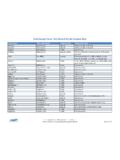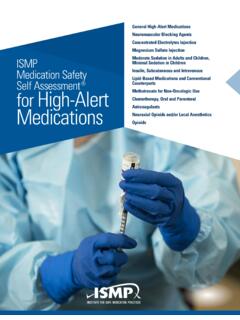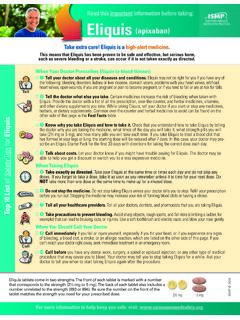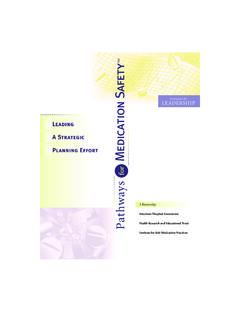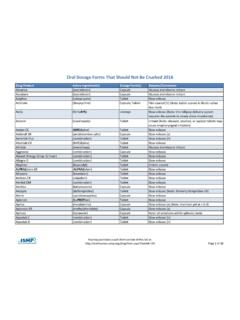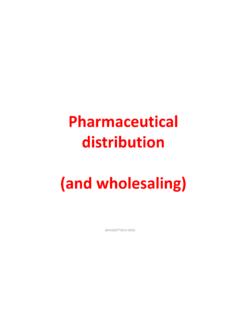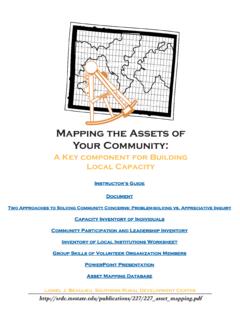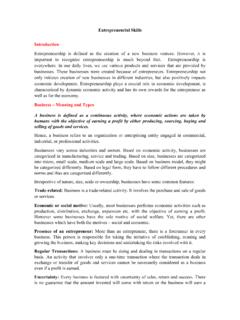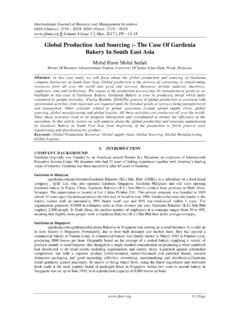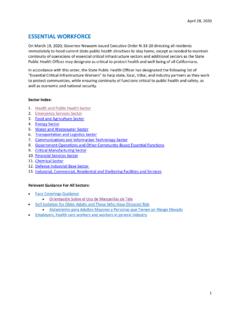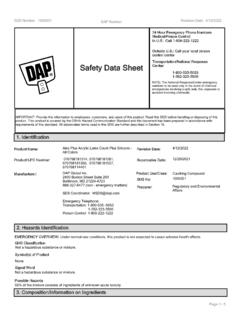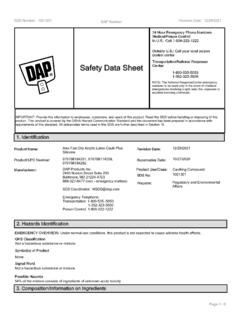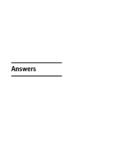Transcription of ISMP Guidelines for Safe Preparation of Compounded Sterile ...
1 Institute for Safe Medication PracticesISMP Guidelines for SafePreparation of CompoundedSterile PreparationsOriginal Publication: 2013 Revised: ISMP 2016 ISMP Guidelines for Safe Preparation of Compounded Sterile PreparationsInstitute for Safe Medication Practices2 TABLE OF CONTENTST able of Contents ..2 Background on Sterile Preparation COMPOUNDING Collaboration ..4 Goals for the Summit ..4 Disclosure ..5 About ISMP ..6 Policies and Procedures for Compounding Sterile Preparations ..6 Order Entry and Verification ..7 Drug inventory Storage ..7 Assembling Products and Supplies for Preparation ..8 Compounding ..8 Drug Conservation ..11 Compounding Performed Outside the Pharmacy IV Admixture Service.
2 11 Preparation of Source/Bulk Containers ..11 Technology/Automation Used for Compounding CSPs ..12 Automated Compounding (Pumping) Systems ..14 Quality Control/Final Verification ..15 Product Labeling ..15 Staff Management ..16 Glossary and Abbreviations ..16 References ..18 APPENDIX A: Summit Participant List ..20 Note:Words within the text of the document presented in all capital letters have a definition in theglossary section at the end of the ISMP 2016 ISMP Guidelines for Safe Preparation of Compounded Sterile PreparationsInstitute for Safe Medication Practicescontinued on next page >3 BACKGROUND ON Sterile Preparation COMPOUNDING SAFETYG eneral informationErrors during pharmacy Preparation of parenteral products and admixtures have frequently beenreported to the ISMP National Medication Errors Reporting Program (ISMP MERP) and have also beena topic of discussion in the ISMP Medication Safety Alert!
3 1-8In addition, a five-hospital observationalstudy on the accuracy of preparing small- and large-volume injectables, chemotherapy solutions, andparenteral nutrition (PN) showed a mean error rate of 9%, meaning almost 1 in 10 products was pre-pared incorrectly prior to rates for complex solutions such as PN were especiallyhigh 37% for manual Preparation and 22% for preparations that were partly automated. A 2009 Stateof Pharmacy Compounding Survey showed that 30% of hospitals have experienced a patient eventinvolving a compounding error in the past 5 national efforts are needed to identify and eliminate or reduce errors and their causative fac-tors. The Institute for Safe Medication Practices (ISMP) held a national invitational Sterile PreparationCompounding Safety Summit on October 25-26, 2011 at the ACE Conference Center in Lafayette Hill,PA.
4 Errors identified through the ISMP MERP and other reporting programs ( , US Food and DrugAdministration MedWatch, MEDMARX), were reviewed. A literature review was also conducted toidentify additional published admixture-related errors. Reports highlighted fatal medication errorsassociated with intravenous (IV) compounding in pharmacies, often involving infants or children. During the 2011 summit, participants were asked a variety of questions regarding best practices whenapplied to Preparation of 1) simple Compounded Sterile preparations (CSPs) (those with one or twoingredients, such as patient controlled analgesia infusions, single electrolyte infusions, bolus doses, ormaintenance IV infusions with no more than two ingredients ), 2) complex CSPs (those with greaterthan two ingredients , such as PN, cardioplegia solutions, or dialysis solutions), 3) pediatric and neona-tal preparations, and 4) chemotherapy.
5 The summit effort resulted in the 2013 publication of ISMPG uidelines for Safe Preparation of Compounded Sterile Preparations. However, since then, ISMP has continued to learn of sentinel events involving IV admixture prepara-tion and dispensing errors. One event that took place was particularly instructive about the need foradditional actions to help prevent errors. A woman arrived for treatment in the emergency department(ED) following brain surgery performed at a different out-of-state hospital. She was supposed toreceive IV fosphenytoin for seizure control. Instead, the pharmacy accidentally added rocuronium tothe IV bag, which was labeled as fosphenytoin. Barcode scanning of the medication was not availablein the pharmacy at the time of the event, and the Preparation error was not identified manually beforethe medication was dispensed to the ED.
6 The rocuronium was administered and caused respiratoryparalysis. The patient experienced cardiopulmonary arrest, and suffered anoxic brain injury. She wastaken off of life support 2 days later and died shortly thereafter. Because the bag was labeled as fos-phenytoin, ED staff had no way of knowing the medication within the bag was rocuronium. Fospheny-toin is generally not considered a high-alert medication, so the drug may not have stepped-up proce-dures during prescribing, preparing, administering, the drug, or monitoring the patient, that ISMP 2016 ISMP Guidelines for Safe Preparation of Compounded Sterile PreparationsInstitute for Safe Medication Practicescontinued on next page >4have provided an opportunity to prevent or catch the error before reaching the patient.
7 As a result of the above case and many others like it that continue to this day, and in light of the factthat barcoding and other IV admixture associated technologies have become available at reasonablecost but are still not widely implemented, it became clear that the previously published guidance need-ed to be updated and revised where necessary. STAKEHOLDER COLLABORATIONOver 60 invitees agreed to attend the original summit (see Appendix A). Those who participated camefrom a variety of backgrounds, including medication safety officers, experts in IV safety technology,pharmacy technicians, pharmacists, nurses, healthcare consumers, and representatives of the medicalproduct vendor community.
8 The meeting was cosponsored by the American Society for Parenteral andEnteral Nutrition ( ) and the American Society of Health-System Pharmacists (ASHP) andattended by a representative from the US Food and Drug Administration (FDA) as well as a representa-tive of the United States Pharmacopeia (USP) Committee that is overseeing future revisions of USPC hapter <797>. Attendees were surveyed prior to the summit to gather information about their facilities, types ofpreparations Compounded , standard practices, quality controls, automated processes, and softwareused related to CSPs. Participants were asked to review and comment on a compendium of ISMP rec-ommended best practices that were sent to all attendees prior to the summit.
9 Those practices with lessthan 90% agreement by attendees were included for discussion during the summit. Based on the pre-summit survey, one-third of responding participants represented hospitals with 100-299 beds and halfwere from hospitals with over 500 summit comprehensively reviewed current methods used to prepare CSPs, identified manual andautomated safeguards to provide assurance that the proper Preparation is dispensed, addressed barri-ers that might inhibit safe practices, and sought to identify and standardize critical quality control prac-tices needed for preparing and verifying the quality and safety of the final CSP. The summit resulted ina set of Guidelines and safe practices, that were agreed upon by consensus to ensure the safe prepara-tion of CSPs.
10 For this revision, ISMP formed an advisory panel composed of members of the Medication SafetyOfficers Society (MSOS). Participants in the revision process are acknowledged in Appendix A. Therewas also a period for public comment, during which we received multiple comments. GOALS FOR THE SUMMITThe goals for the summit included: Review currently employed quality control measures used to ensure the correct Preparation ISMP 2016 ISMP Guidelines for Safe Preparation of Compounded Sterile PreparationsInstitute for Safe Medication quality control practices that should be standardized for incorporation into the to ensure the correct Preparation of CSPs. Describe current and emerging technologies that assist the Preparation and quality control and how these technologies are the minimum safeguards that must be in place to prepare and dispense CSPs.
